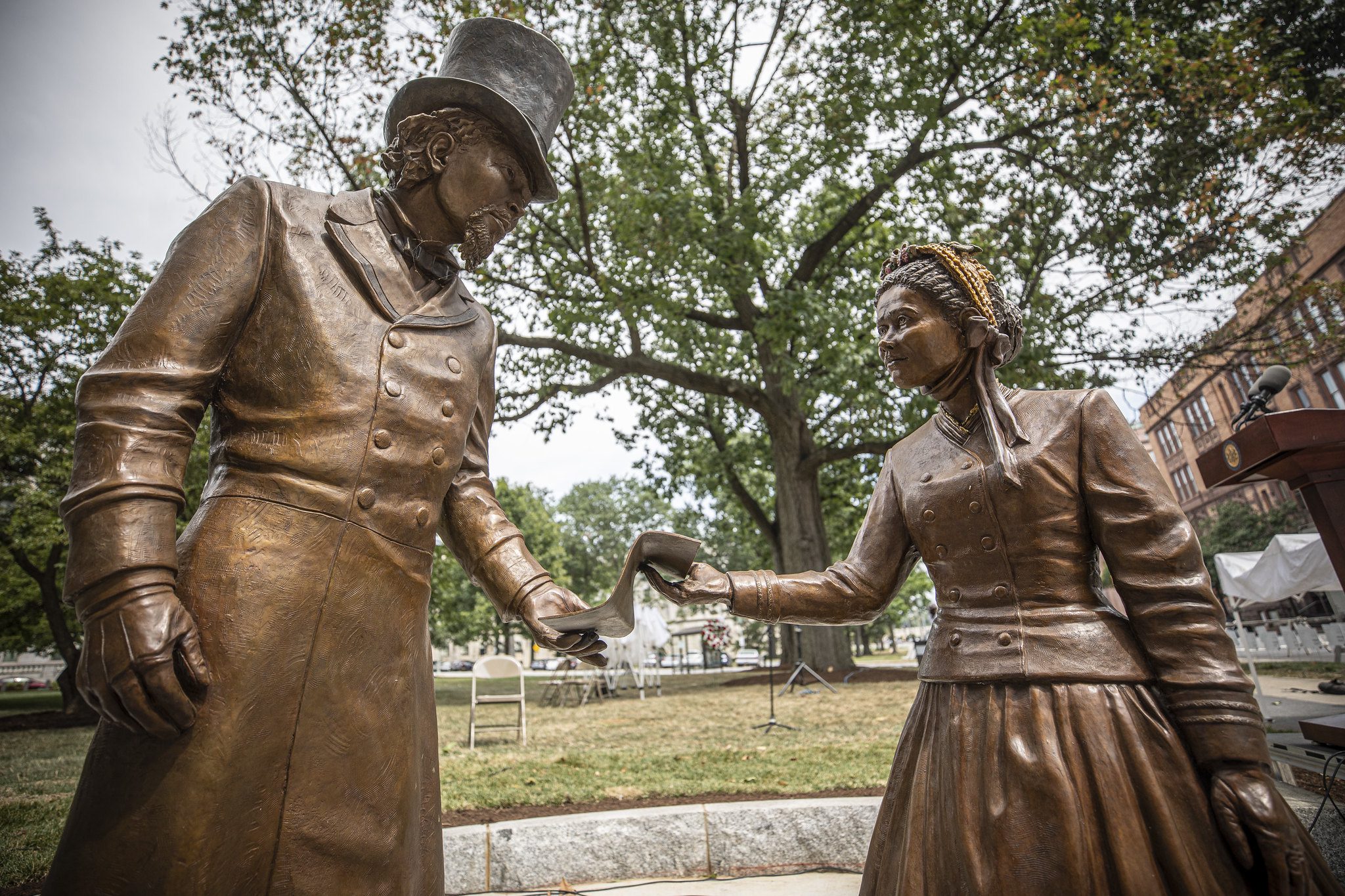Correcting the Anti-Black Civil War Commemorative Landscape in Harrisburg, PA
This post is part of our online forum on Black Military Families in the Nineteenth Century.

Dedicated during the national reckoning of Confederate monuments, A Gathering at the Crossroads monument served as a corrective. The interactive monument featuring William Howard Day, Thomas Morris Chester, Frances Ellen Watkins Harper, and Jacob Compton, a Twenty-Fourth USCT veteran, stands on the Pennsylvania Capitol Complex grounds. It recognizes three Black Pennsylvanians who advanced abolition, equitable USCT enlistment and service, and ensured returning Black veterans received a grand reception in November 1865. After the Civil War, all strove for ensuring Black Pennsylvanians’ sacrifice on and outside the battlefield materialized with the Fifteenth and Nineteenth Amendments. Now enshrined in bronze on the capitol grounds, Black Pennsylvanians’ Civil War memory endured.
The monument reflected a significant change. Black Pennsylvanians and their white allies made explicit public claims regarding the Civil War commemorative landscape. The monumental addition altered previous racial geographies. Unlike the United Daughters of the Confederacy memorials under public scrutiny in 2020, this memorial does not enact the “know-your-place-aggression” described by Koritha Mitchell. Rather, the Harrisburg monument invites spectators to learn an underappreciated Civil War era history.
During the late nineteenth and twentieth centuries, Black Pennsylvanians embraced segregated cemeteries as sites of Black Civil War commemoration. In the late 1870s, Black Harrisburg women erected and dedicated a monument honoring Civil War veterans at the Lincoln Cemetery which served as the final resting place for many veterans and former abolitionists. The Harrisburg State Journal described the modest monument as follows: “A handsome monument has been erected to memory of the dead soldiers.”1 By anchoring Civil War memory in the segregated safe space, the first monument ensured Civil War soldiers and veterans received their laurels during the annual Memorial Day rituals.
On Memorial Day 1950, the Black Harrisburg community dedicated its second Civil War monument at the Lincoln Cemetery. W.E. B. Du Bois delivered the main dedication speech for the modest monument honoring William Howard Day. “It is our duty,” Du Bois reminded attendees, “as men and women living in this new day to understand and understand thoroughly what has taken place since the death of William Howard Day.”2 He hoped that by understanding his world, achievements, and lasting memory that Day might inspire the twentieth-century activists attending the ceremonies. “But doing this work we cannot forget the full life and real service of this intelligent, busy and unselfish servant of man,” Du Bois closed. While the nation forgot Day, USCT soldiers, and the returning veterans celebrated in November 1865, Black Harrisburg residents and national Black leaders never forgot their legacy and the role of race in shaping the collective erasure.
Sculpted by Becky Ault, A Gathering at the Crossroads monument corrects Civil War commemorative silences. Appearing to discuss the passage of the Fifteenth Amendment, Ault encourages an immersive experience. In between the four individuals, she placed a pedestal with a map of the historic Black Eighth Ward community and the selected names of 100 individuals on the pedestal sides. The map notes Wesley Union AME Church, schools, businesses, hotels, and other neighborhood locales.
Ault took immense care in realistically capturing the four individuals’ likenesses, dresses, and personalities. For Chester and Day, she used their poses, features, and clothing to communicate their strong character, knowledge, and inner strength to fight for a more just society. Relying on historical photographs, Ault captured the joyful expression of Harper while holding a copy of the Fifteenth Amendment and her continued drive to secure the franchise for Black women. Unlike the other figures, the Compton statue emphasized a specific monument in Civil War history. Ault did not depict him as either a Twenty-Fourth USCT soldier or one of the African American civilians who defended Harrisburg against the threat posed by Confederate soldiers during the Gettysburg campaign. Rather, she highlighted the bravery he showed during an assassination attempt of Abraham Lincoln during his visit in 1861. With an equally detailed pedestal in between the life-size figures, this monument does more to educate than whitewash Civil War history. Each figure and name on the pedestal corrects the previous silencing of the Civil War past. The final monument introduces new heroes and heroines who shaped the “history of the city, county, commonwealth and nation.”3
With the 160th Civil War commemorations underway, we should remember these recent additions to the landscape and not the ones removed. The Harrisburg example reflects a possible direction for learning about the Black Pennsylvanian Civil War experience and other stories that have yet to be told either on the page or in bronze.
- “Lincoln Cemetery,” State Journal (Harrisburg, PA), April 5, 1884, 2. ↩
- W. E. B. Du Bois, “The World of William Howard Day,” May 30, 1950, speech made at Lincoln Cemetery, Penbrook, PA, accessed at Western Reserve Historical Society, Cleveland, OH. ↩
- Becky Ault, “The Commonwealth Memorial: A New Sculpture for the Capitol Grounds,” Pennsylvania History: A Journal of Mid-Atlantic Studies 87, no. 1 (Winter 2020): 232. ↩

A team of student and faculty researchers from Messiah University in nearby Mechanicsburg, PA, contributed significantly to the Commonwealth Monument Project through the university’s Digital Harrisburg initiative (https://digitalharrisburg.com/commonwealth/). Messiah’s work was supported, in part by a grant from the Council of Independent Colleges (CIC) and the Mellon Foundation. Messiah University is also an Institutional Affiliate of CIC’s Legacies of American Slavery network, which is helping small colleges and their communities reckon with the memories and multiple legacies of slavery (www.legaciesofslavery.net).